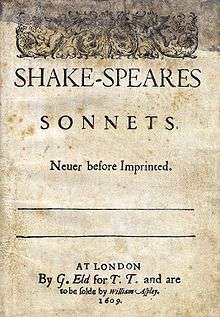Sonnet 96
| Sonnet 96 | |||||||
|---|---|---|---|---|---|---|---|
 The first five lines of Sonnet 96 in the 1609 Quarto | |||||||
|
| |||||||
| |||||||
Sonnet 96 is one of 154 sonnets written by the English playwright and poet William Shakespeare. It is a member of the Fair Youth sequence, in which the poet expresses his love towards a young man.
Synopsis
The youth's errors are blamed on his age, but others say young gentlemen should enjoy themselves. The youth's faults appear to be charms, just as poor-quality jewels on a queen appear to be more valuable by their association with her. The follies of the youth appear to be truths that some may want to erroneously emulate, like wolves who appear to be lambs and lead the lambs astray. The youth could do the same, but should not do so, because the poet's disapproval of such behavior undermines his good report of the youth, and such behaviour will also reflect badly on the poet.
Structure
Sonnet 96 is an English or Shakespearean sonnet. The English sonnet has three quatrains, followed by a final rhyming couplet. It follows the typical rhyme scheme of the form, abab cdcd efef gg and is composed in iambic pentameter, a type of poetic metre based on five pairs of metrically weak/strong syllabic positions. The 3rd line exemplifies a regular iambic pentameter:
× / × / × / × / × / Both grace and faults are lov'd of more and less: (96.3)
- / = ictus, a metrically strong syllabic position. × = nonictus.
The 9th line presents a case of metrical ambiguity. Probably the simplest scansion features only one metrical variation, a mid-line reversal:
× / × / / × × / × / How many lambs might the stern wolf betray, (96.9)
However, both this part of the line and the beginning of the line may be construed differently, depending upon the elements the reader sees fit to emphasize. The line may be scanned with an initial reversal, and with the rightward movement of the third ictus (resulting in a four-position figure, × × / /, sometimes referred to as a minor ionic):
/ × × / × × / / × / How many lambs might the stern wolf betray, (96.9)
These alternatives are independent, resulting in four distinct possible scansions for the line.
The meter demands a few variant pronunciations: line 5's "thronèd" is two syllables,[2] and line 14's "being" is one.[3] In lines 8 and 10 "translated" and "translate" are both stressed on the second syllable.[4]
Notes
- ↑ Pooler, C[harles] Knox, ed. (1918). The Works of Shakespeare: Sonnets. The Arden Shakespeare [1st series]. London: Methuen & Company. OCLC 4770201.
- ↑ Booth 2000, p. 83.
- ↑ Booth 2000, p. 313.
- ↑ Groves, Peter (2013). Rhythm and Meaning in Shakespeare: A Guide for Readers and Actors. Melbourne: Monash University Publishing. p. 170. ISBN 978-1-921867-81-1.
References
- First edition and facsimile
- Shakespeare, William (1609). Shake-speares Sonnets: Never Before Imprinted. London: Thomas Thorpe.
- Lee, Sidney, ed. (1905). Shakespeares Sonnets: Being a reproduction in facsimile of the first edition. Oxford: Clarendon Press. OCLC 458829162.
- Variorum editions
- Alden, Raymond Macdonald, ed. (1916). The Sonnets of Shakespeare. Boston: Houghton Mifflin Company. OCLC 234756.
- Rollins, Hyder Edward, ed. (1944). A New Variorum Edition of Shakespeare: The Sonnets [2 Volumes]. Philadelphia: J. B. Lippincott & Co. OCLC 6028485.
- Modern critical editions
- Atkins, Carl D., ed. (2007). Shakespeare's Sonnets: With Three Hundred Years of Commentary. Madison: Fairleigh Dickinson University Press. ISBN 978-0-8386-4163-7. OCLC 86090499.
- Booth, Stephen, ed. (2000) [1st ed. 1977]. Shakespeare's Sonnets (Rev. ed.). New Haven: Yale Nota Bene. ISBN 0-300-01959-9. OCLC 2968040.
- Burrow, Colin, ed. (2002). The Complete Sonnets and Poems. The Oxford Shakespeare. Oxford: Oxford University Press. ISBN 978-0192819338. OCLC 48532938.
- Duncan-Jones, Katherine, ed. (2010) [1st ed. 1997]. Shakespeare's Sonnets. The Arden Shakespeare, Third Series (Rev. ed.). London: Bloomsbury. ISBN 978-1-4080-1797-5. OCLC 755065951.
- Evans, G. Blakemore, ed. (1996). The Sonnets. The New Cambridge Shakespeare. Cambridge: Cambridge University Press. ISBN 978-0521294034. OCLC 32272082.
- Kerrigan, John, ed. (1995) [1st ed. 1986]. The Sonnets ; and, A Lover's Complaint. New Penguin Shakespeare (Rev. ed.). Penguin Books. ISBN 0-14-070732-8. OCLC 15018446.
- Mowat, Barbara A.; Werstine, Paul, eds. (2006). Shakespeare's Sonnets & Poems. Folger Shakespeare Library. New York: Washington Square Press. ISBN 978-0743273282. OCLC 64594469.
- Orgel, Stephen, ed. (2001). The Sonnets. The Pelican Shakespeare (Rev. ed.). New York: Penguin Books. ISBN 978-0140714531. OCLC 46683809.
- Vendler, Helen, ed. (1997). The Art of Shakespeare's Sonnets. Cambridge, MA: The Belknap Press of Harvard University Press. ISBN 0-674-63712-7. OCLC 36806589.
.png)
